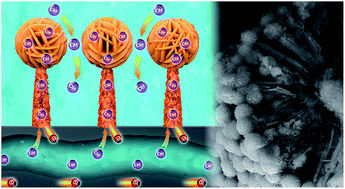MnCo2S4/FeCo2S4 “lollipop” arrays on a hollow N-doped carbon skeleton as flexible electrodes for hybrid supercapacitors†
Abstract
Rationally designing and engineering electrodes with multiple components and favorable architectures is an effective way to modulate their electrochemical performance. Here, we present the tailored synthesis of a novel 3D macroporous electrode with hierarchical lollipop-like MnCo2S4/FeCo2S4 heterostructures immobilized on a flexible N-doped carbon matrix, which delivers a high specific capacitance of 2806 F g−1 (capacity of 1403 C g−1) at 1 A g−1 and excellent cycling stability (85.1% of its initial value after 5000 cycles). Moreover, a hybrid supercapacitor device based on the self-supported MnCo2S4/FeCo2S4/N-CMF electrode achieves a high energy density of 87.3 W h kg−1 at a power density of 799.9 W kg−1 and great electrochemical stability under bending conditions. This remarkable capacitive performance is attributed to the collaborative contribution from three components involving the enhanced charge transfer on the 3D interconnected carbon matrix, the unique ion-diffusion “short-cuts” provided by the hollow interior of the carbon skeleton, the abundant void space and electroactive sites in sheet-built MnCo2S4 spheres and rough FeCo2S4 nanoneedles, and great structural stability of firmly connected MnCo2S4/FeCo2S4 “lollipops”. Thus, this work offers insight into the rational construction of transition metal sulfide complexes for next-generation high-performance supercapacitors.



 Please wait while we load your content...
Please wait while we load your content...